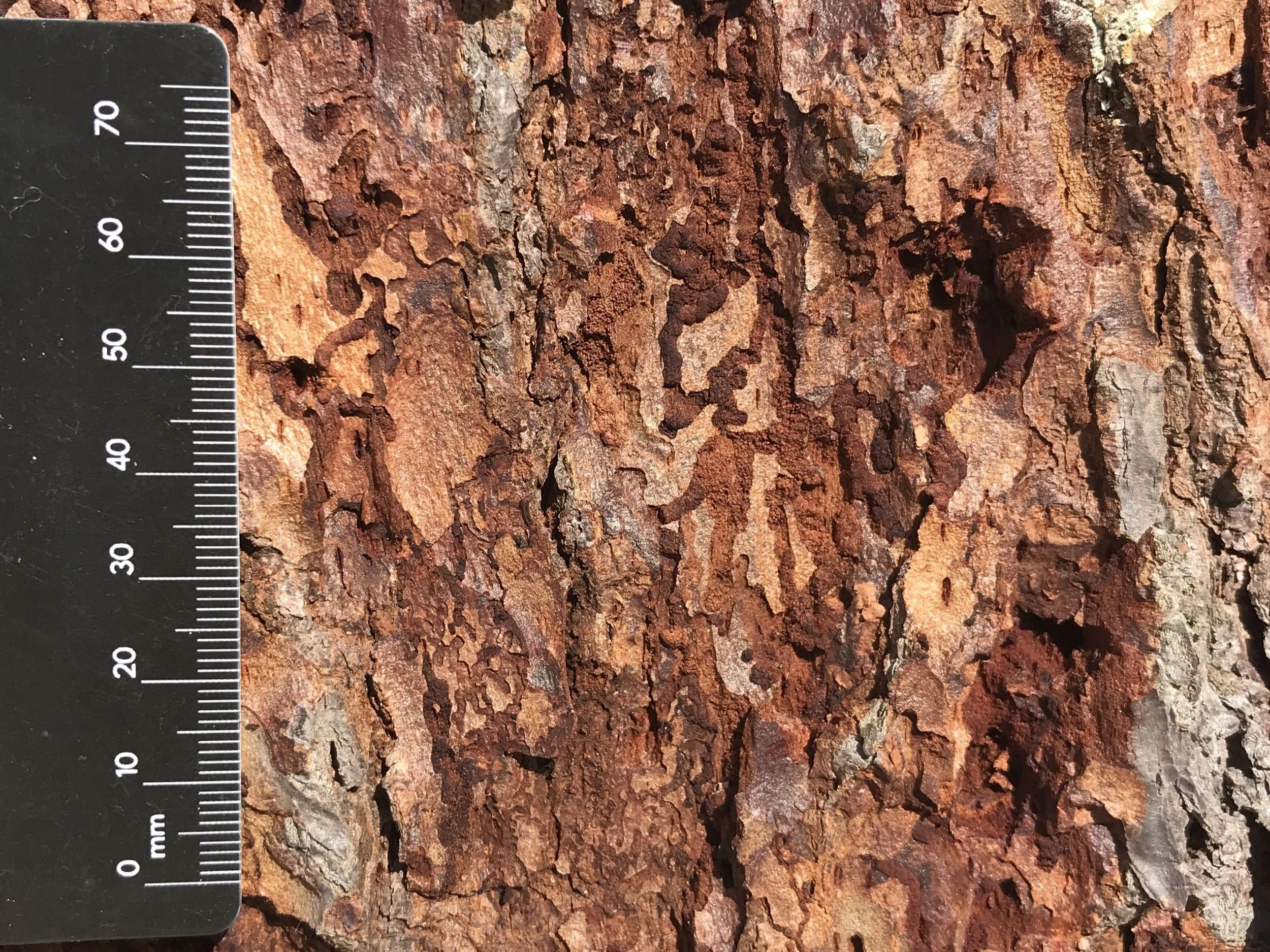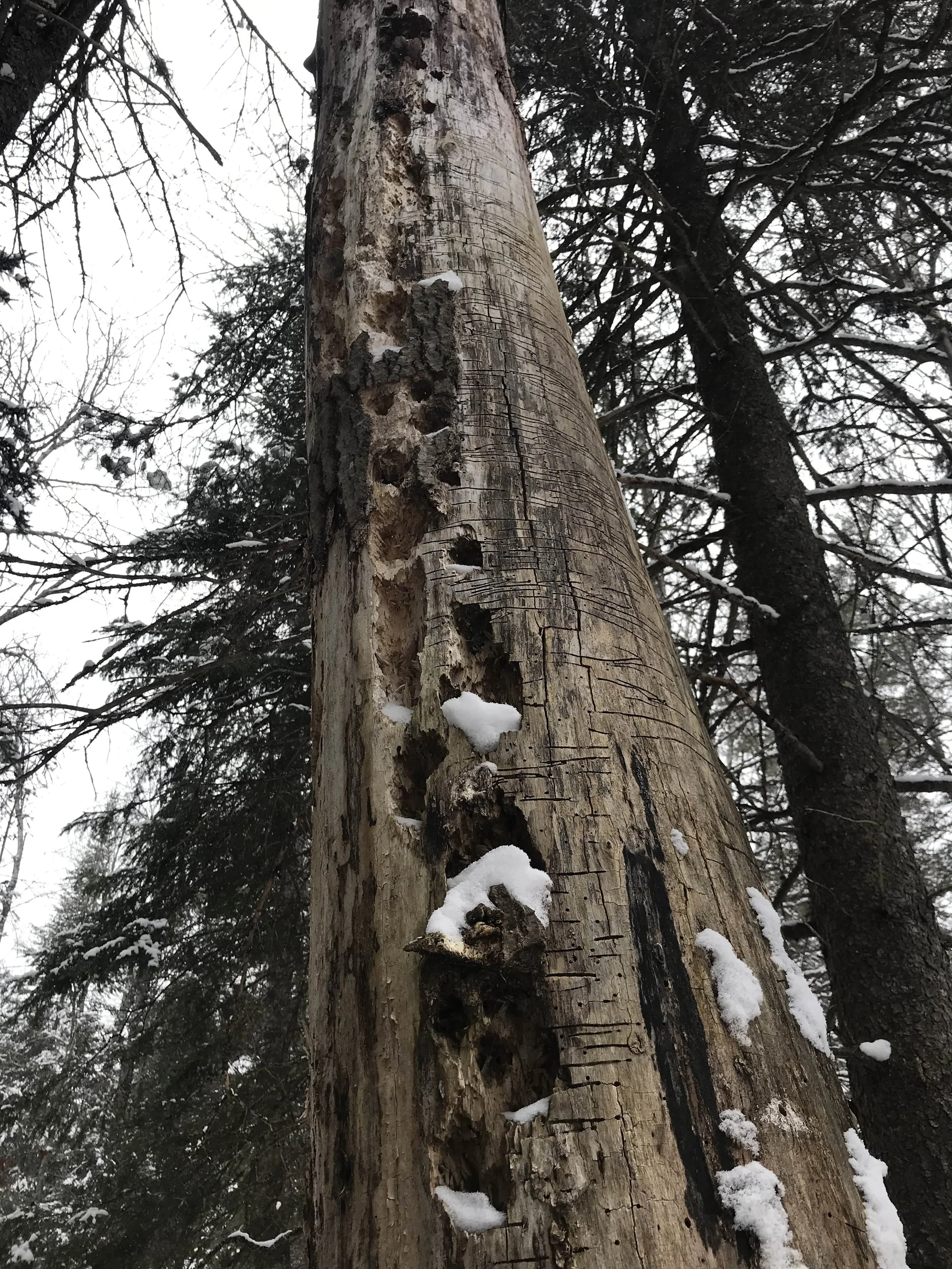Sign of Birds in Algonquin Park
This year I wanted to keep birds in focus and at front of mind in my ongoing learning about wildlife tracking. I wanted to do this because birds are often overlooked when folks think of looking for tracks and sign in the field, even though there is often so much to find. Obviously track and sign is a way to really get to know the birds better and to deepen our relationships with them, and I wanted to continue along that path, especially since it can be hard to find good resources or tools to help interpret what we are seeing on the land.
While in Algonquin Park this past week with the Earth Tracks Winter Wildlife Tracking Trip I tried to pay more attention to some of the bird sign throughout our days, though I didn’t always get some good photos, and I missed recording some beautiful songs and calls. I will share however what I did find in the park and what I have been able to learn thus far.
Pine Siskin (Spinus pinus)
Pine Siskins were my focal species for the week. That meant that every night before I ate I would research something particular about the Siskins and share this fact or discovery with the group. This was a great intro to the Siskin and helped me realize I didn’t know much at all about them… which was just the right inspiration to learn more.
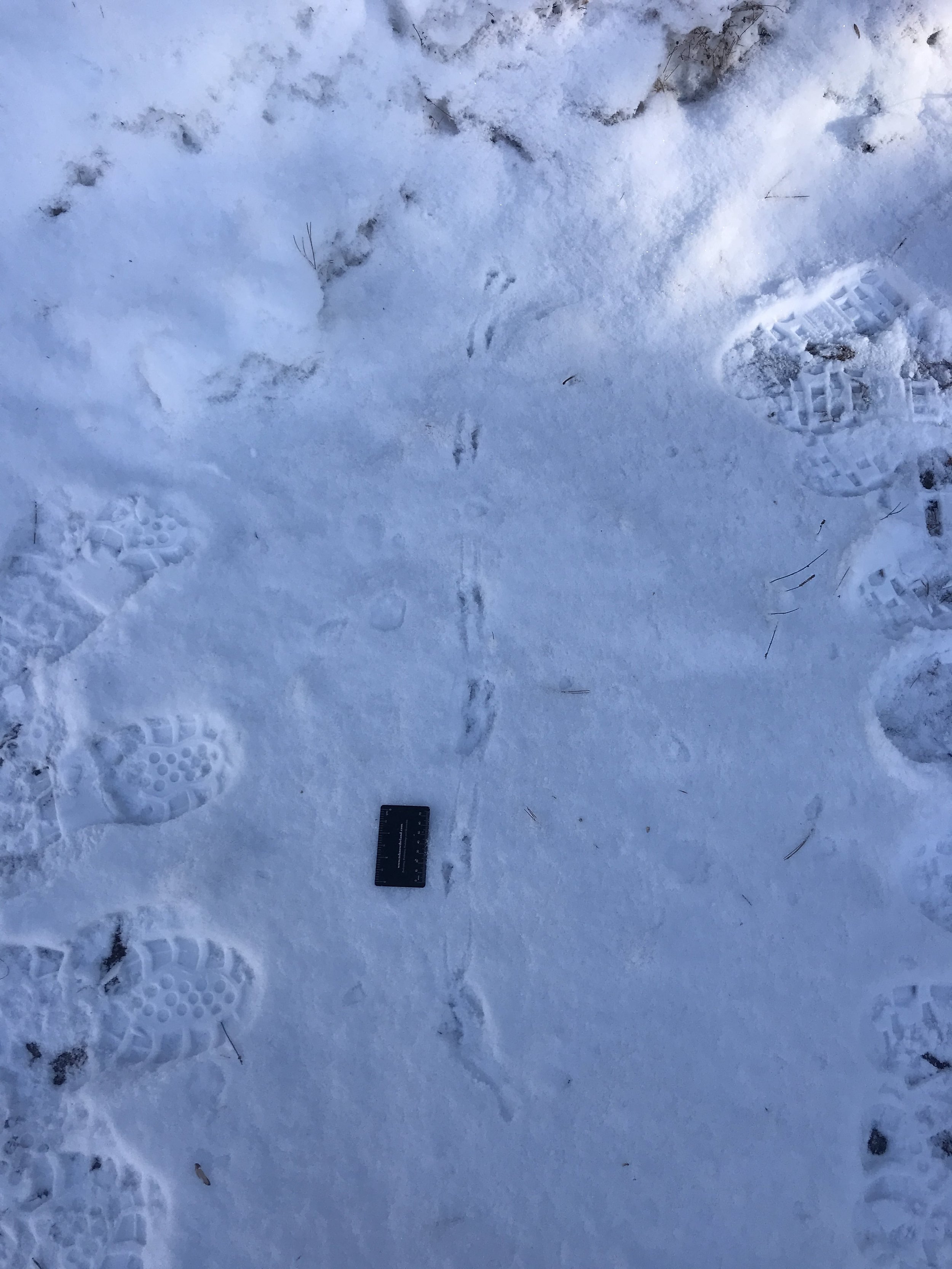
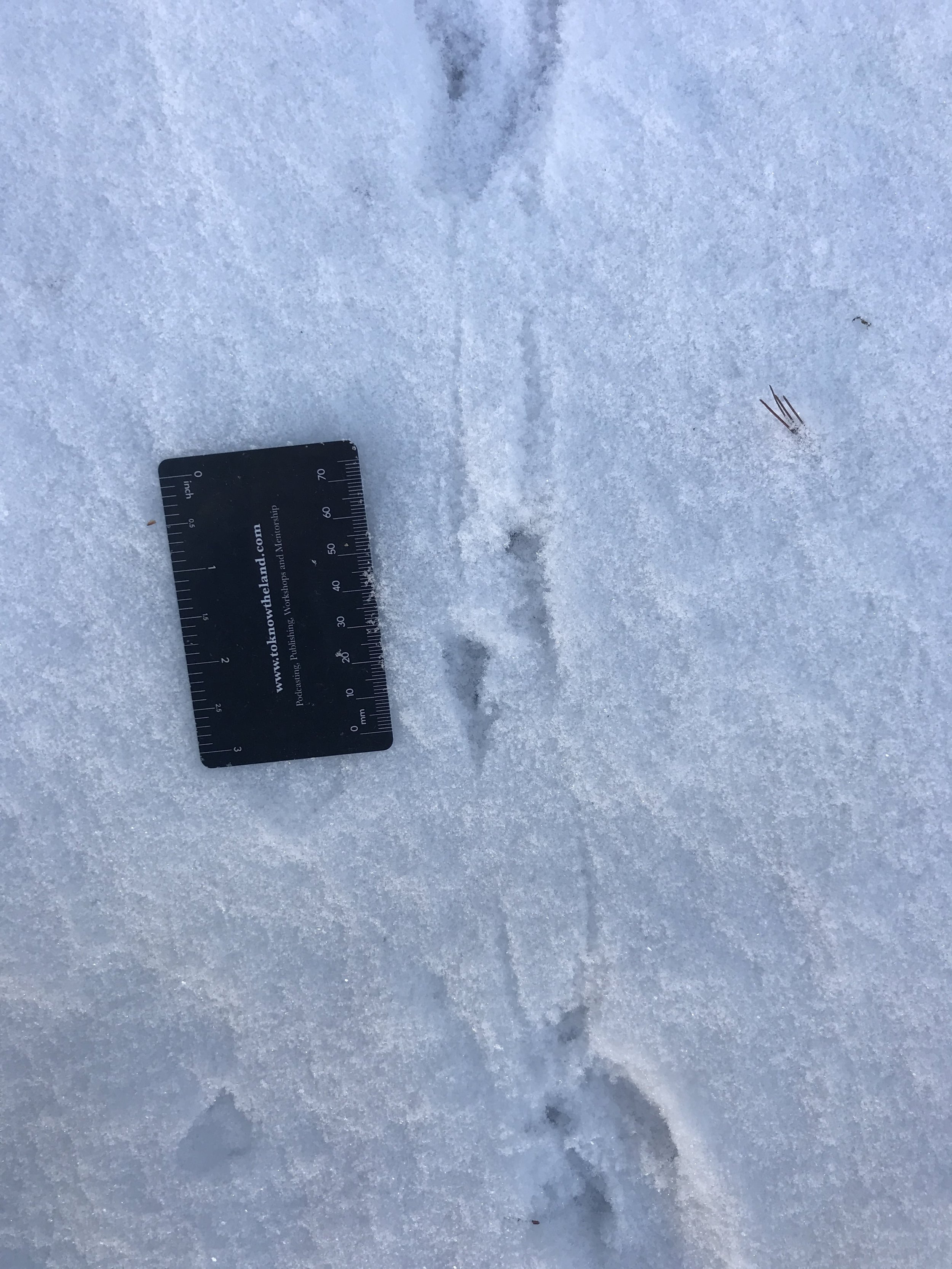
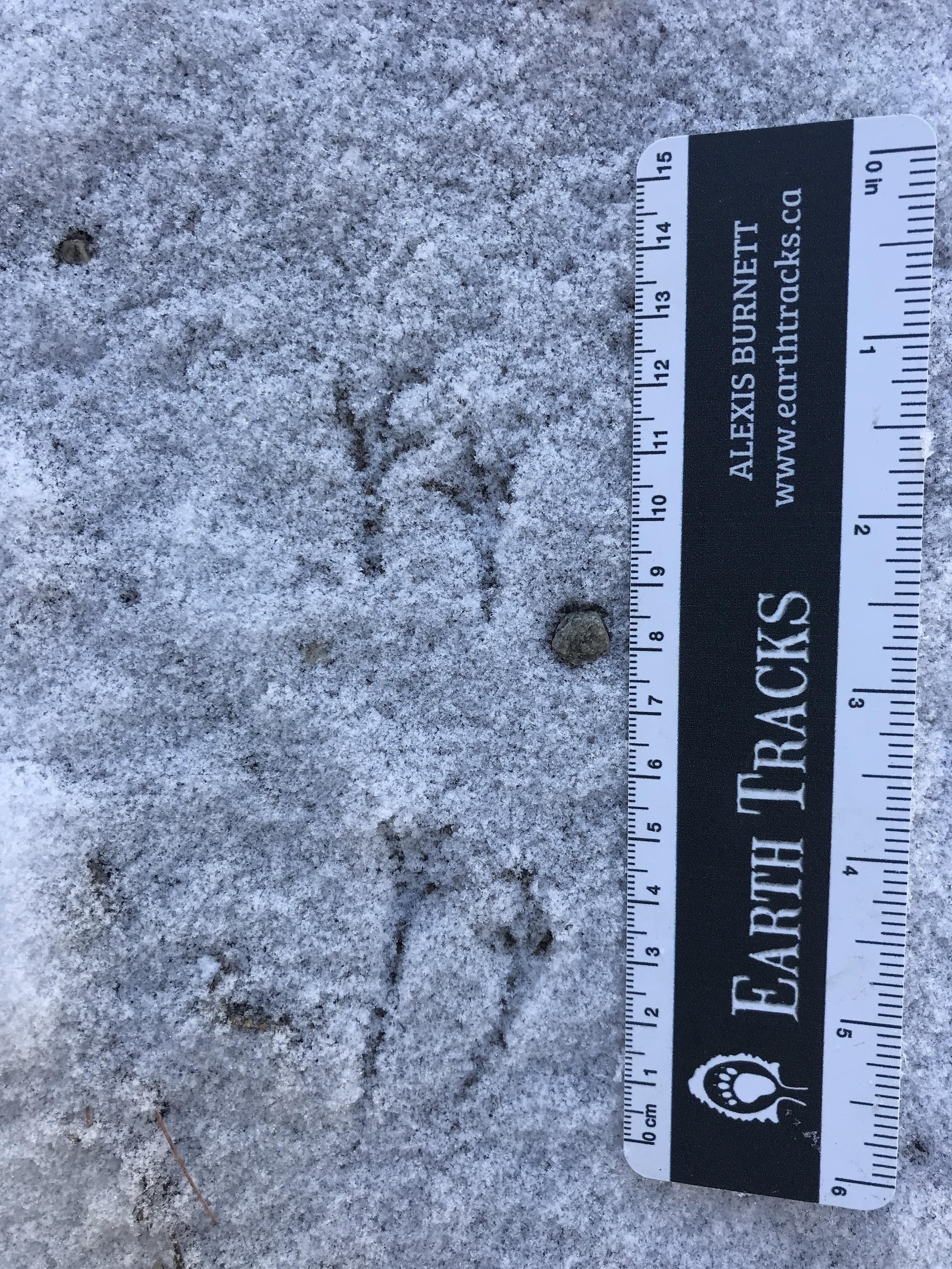
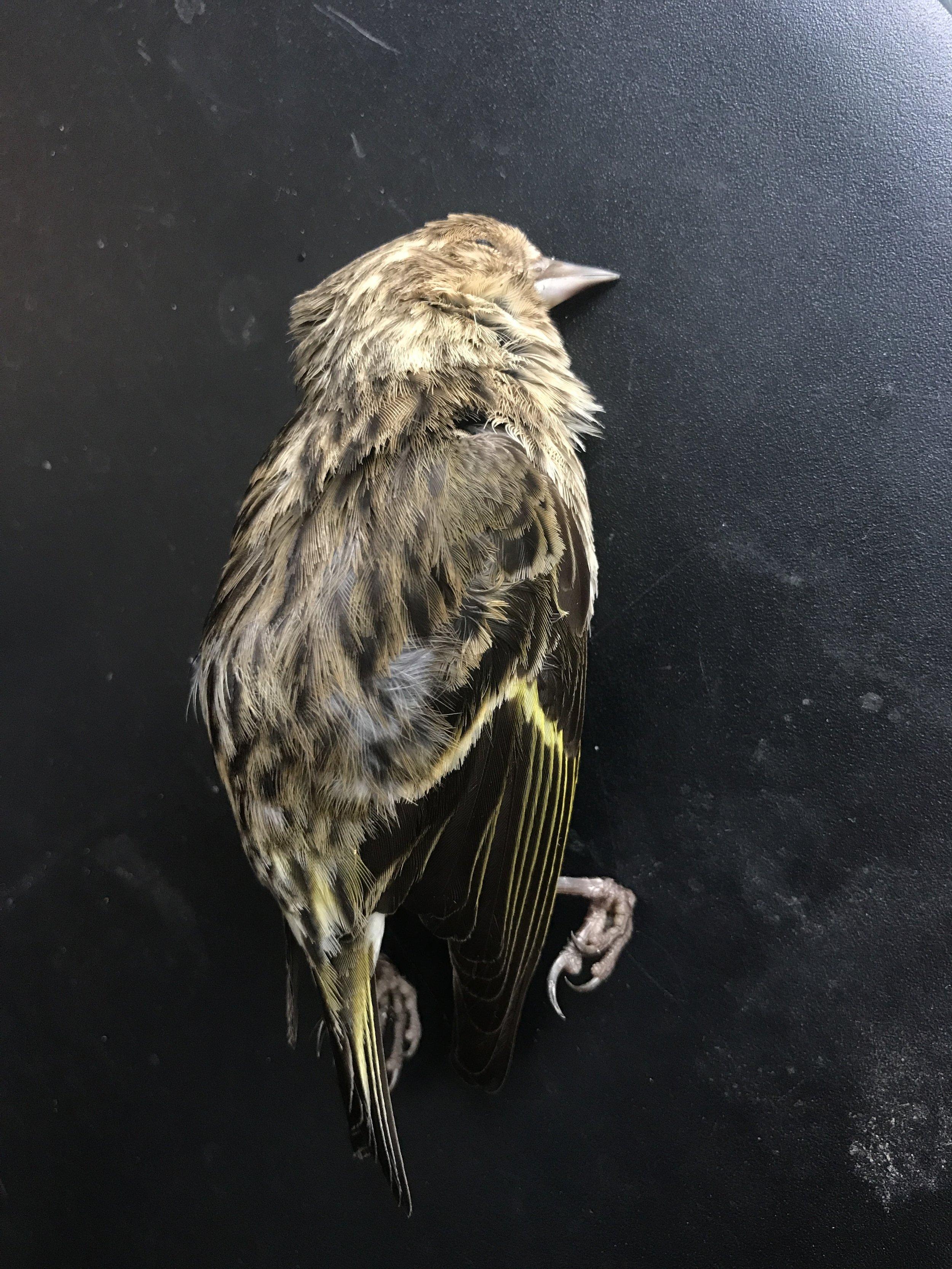
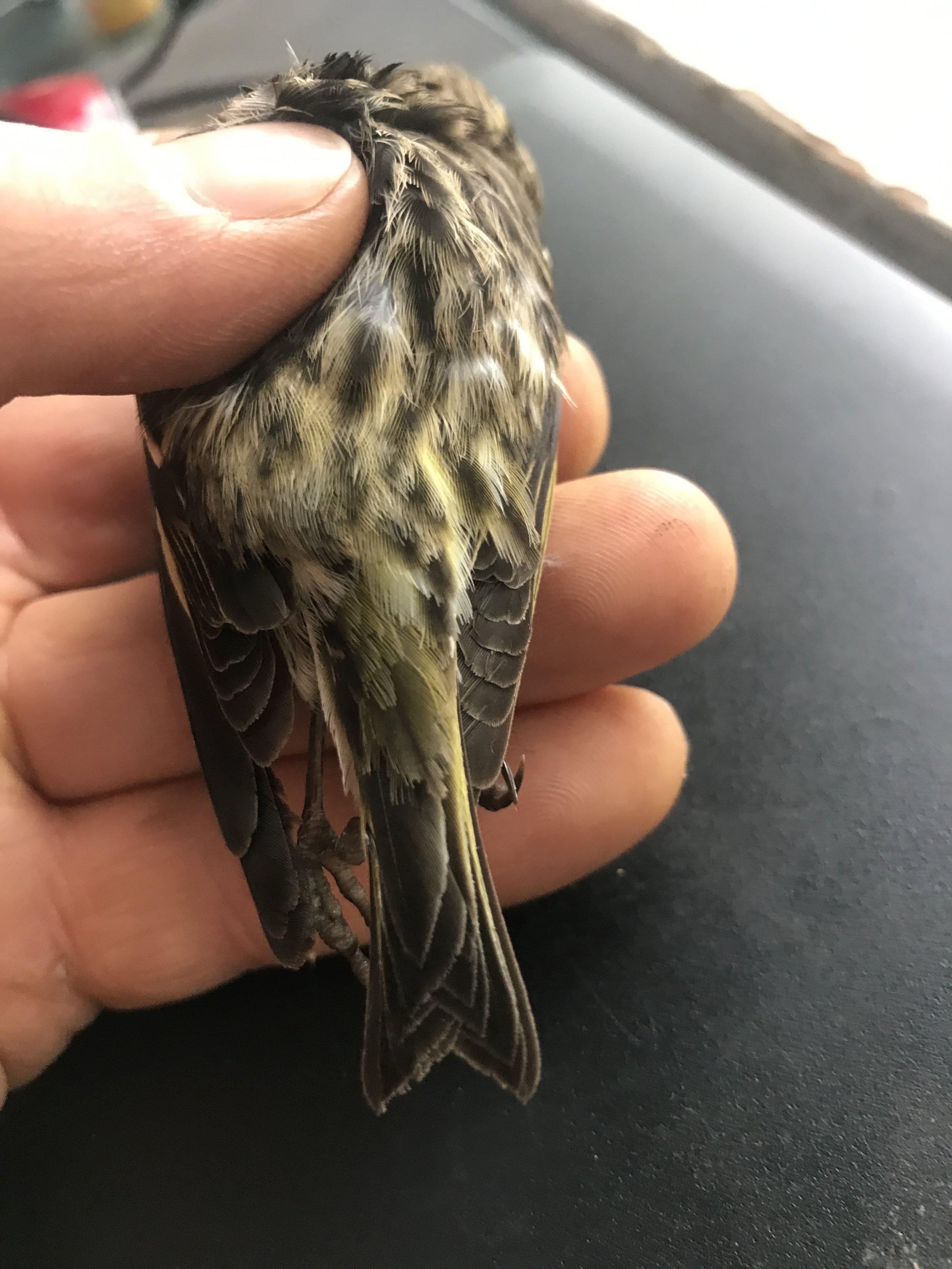
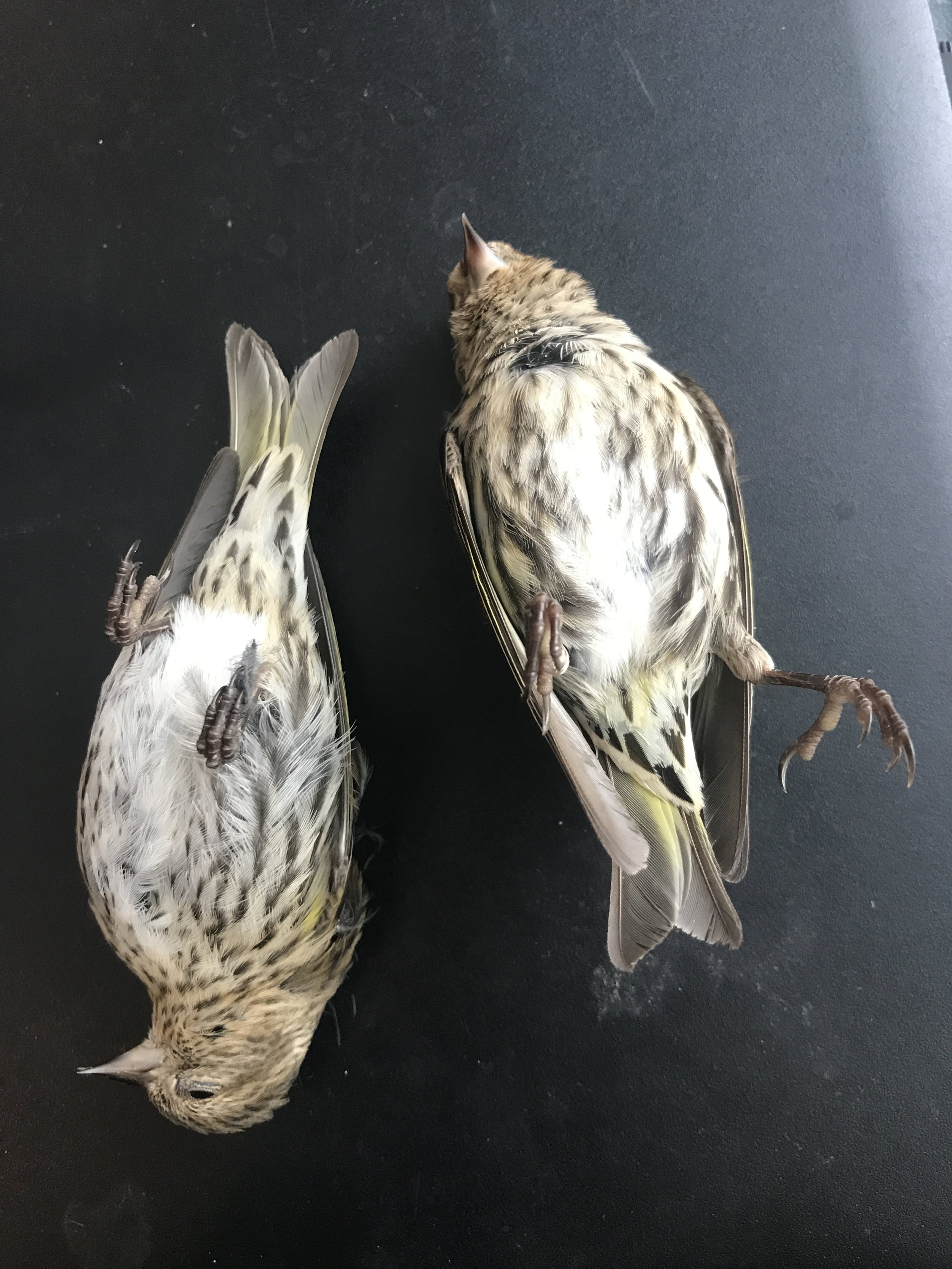
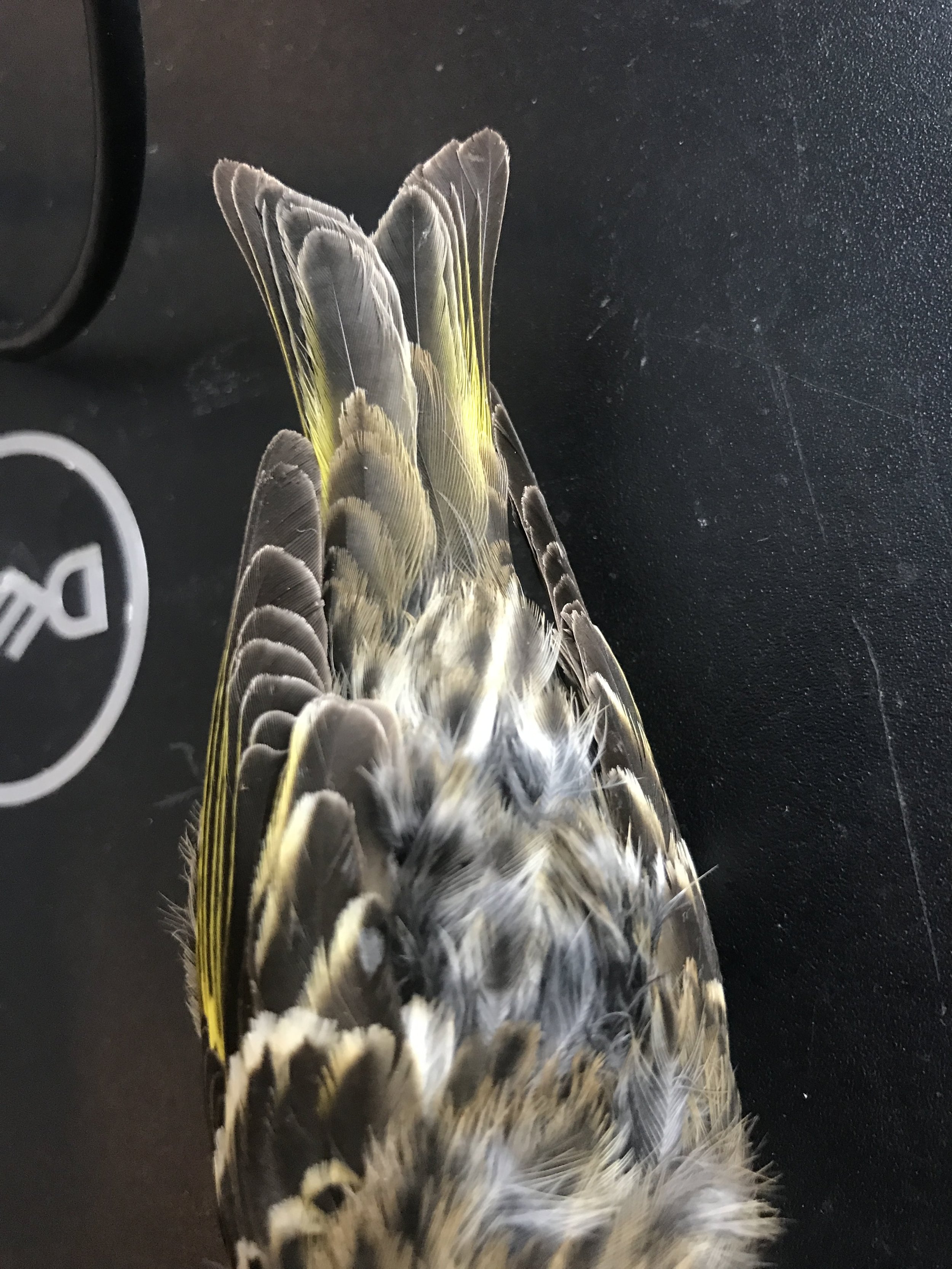
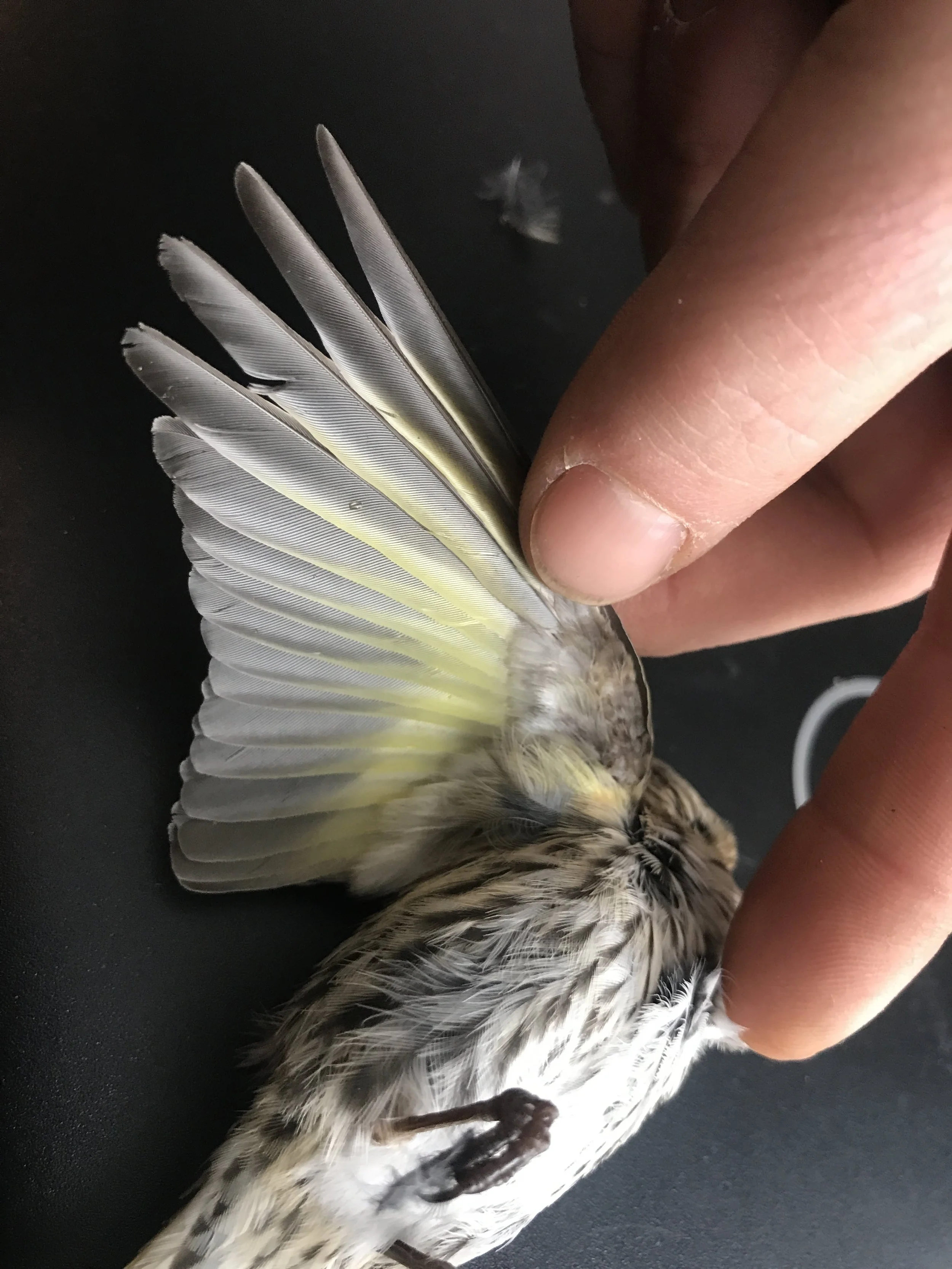
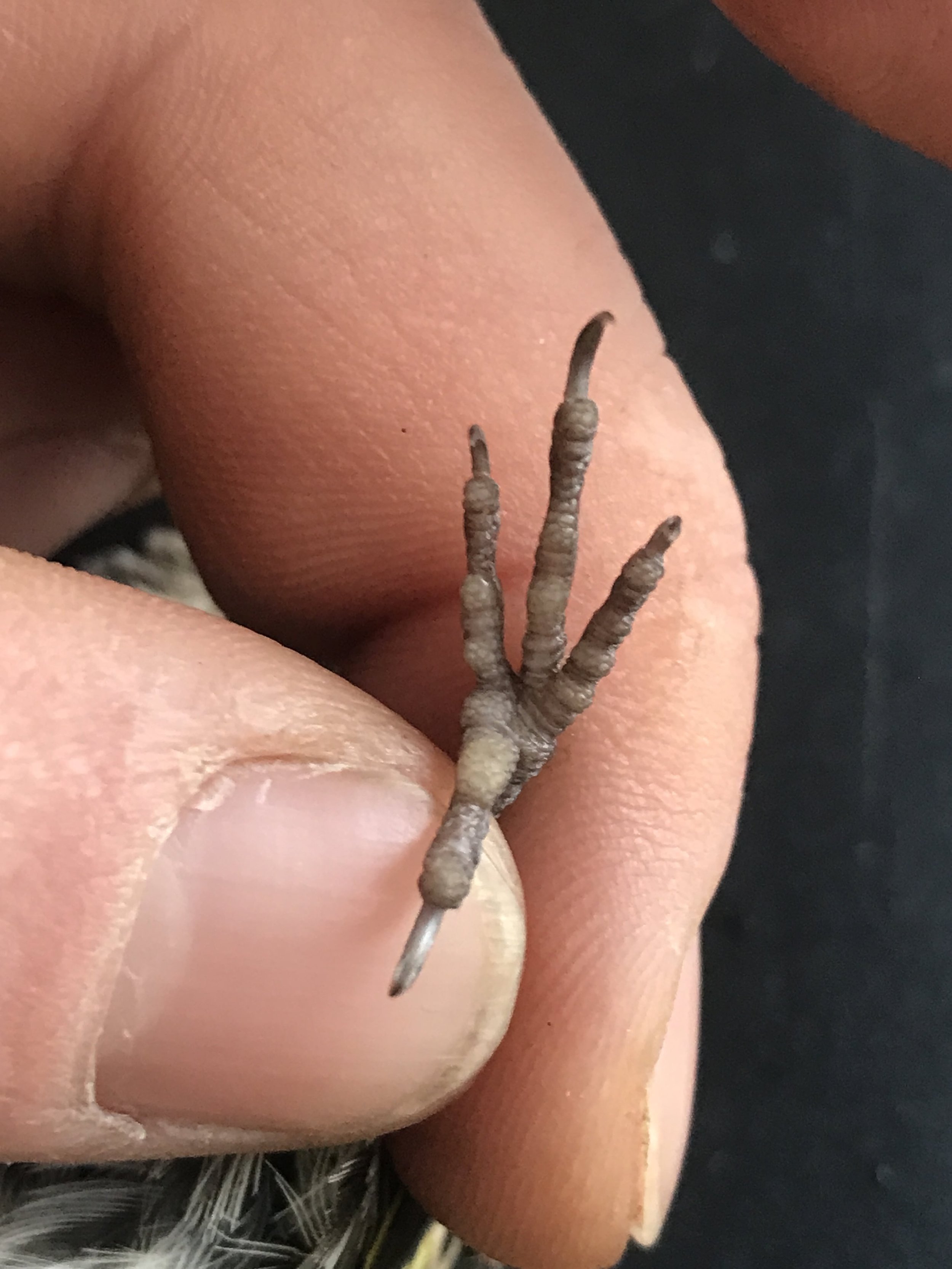
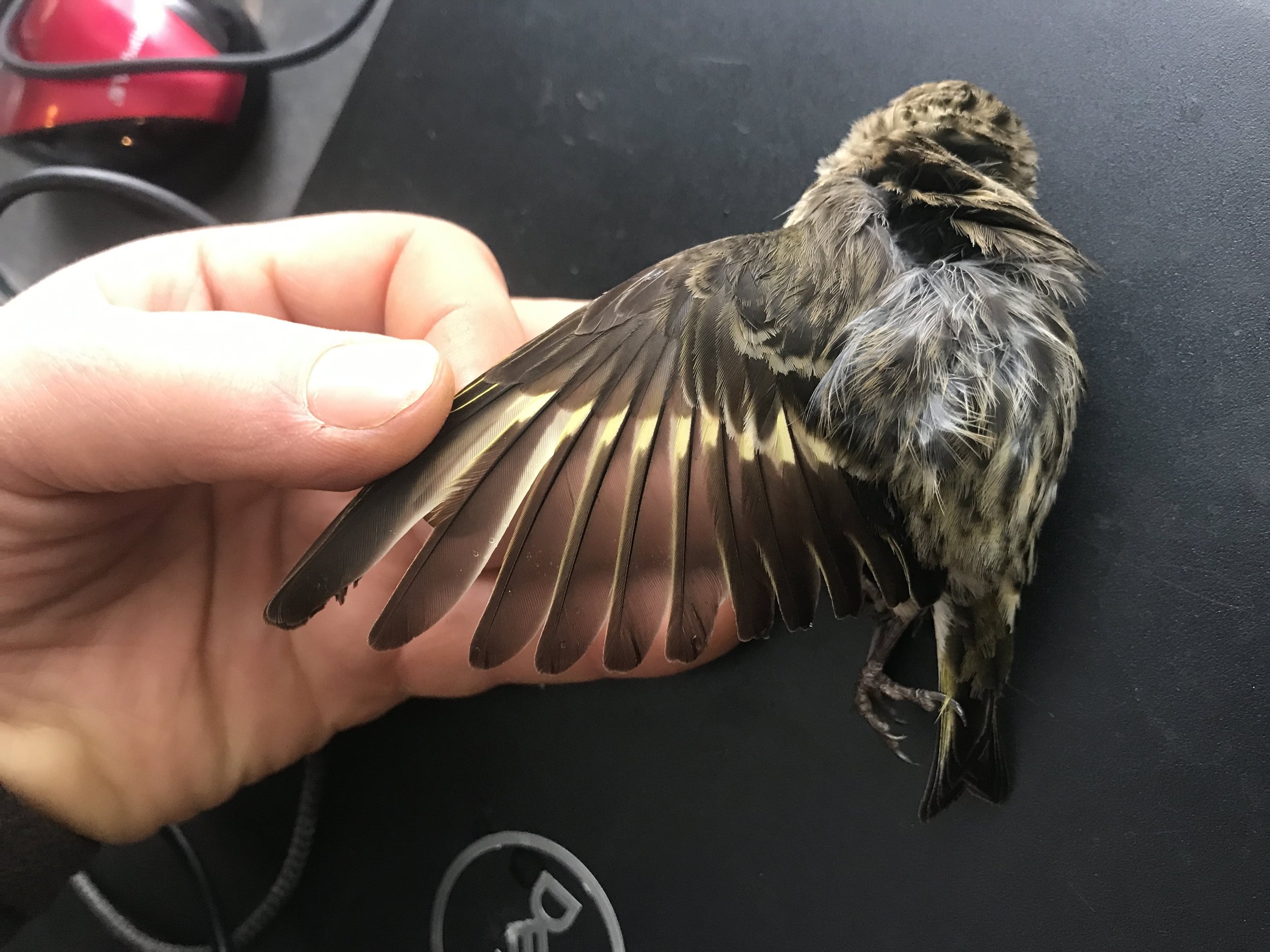
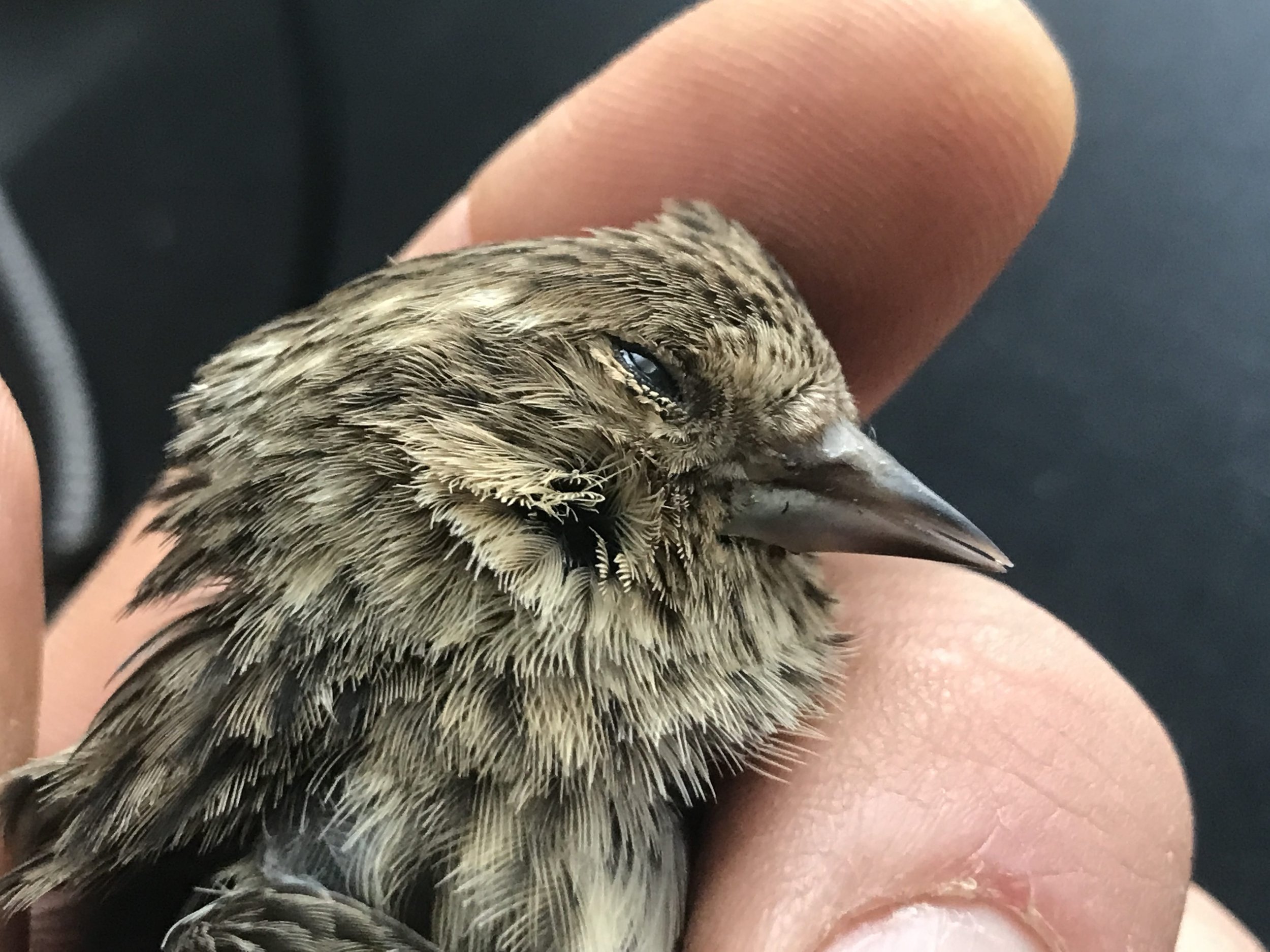
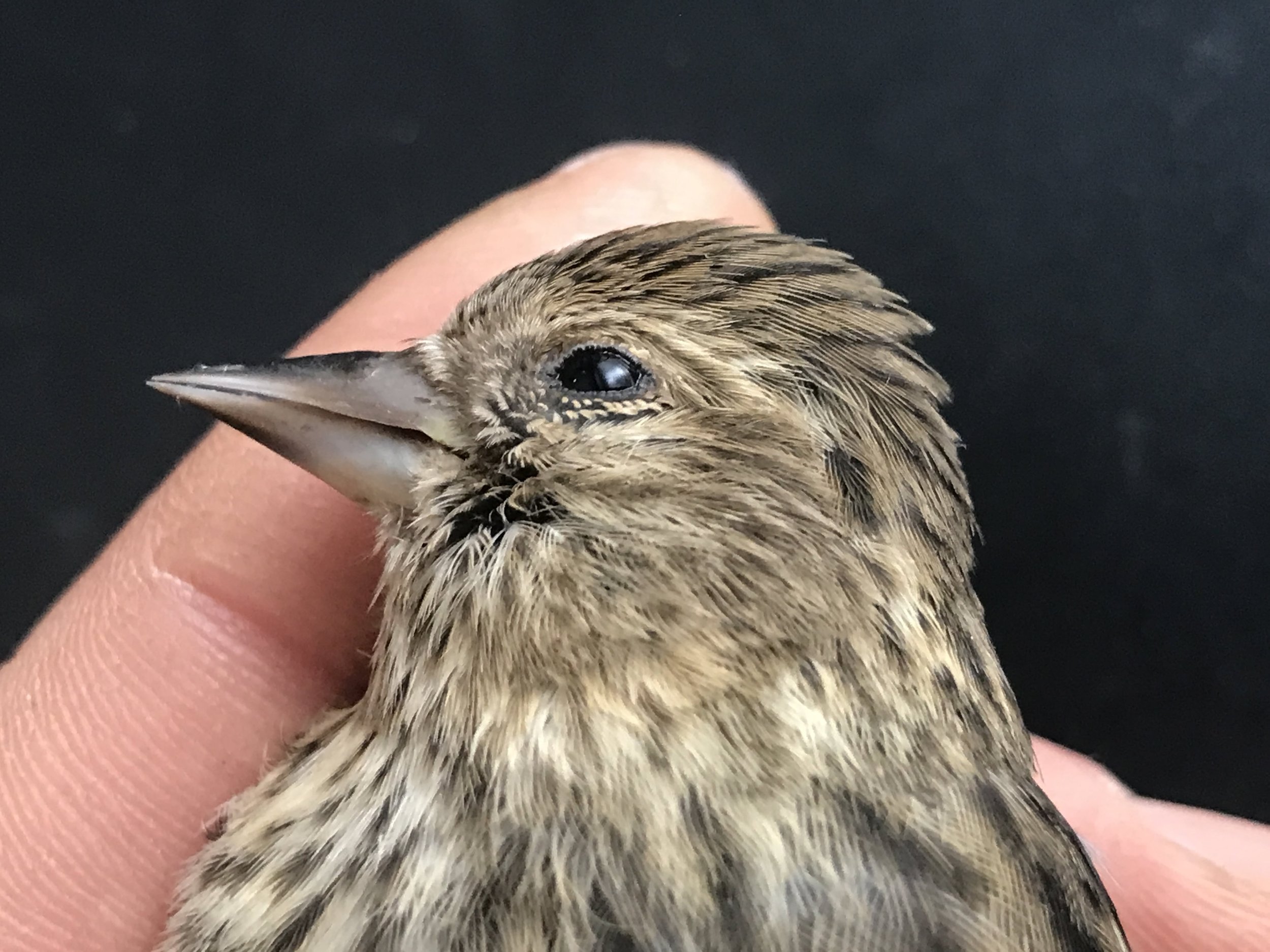
Pine Siskin tracks measured 2.7 - 3.1 cm (1 1/16 - 1 1/8") L X 0.8 - 1.3 cm (5/16 - ~1/2") W. They often hopped and skipped in their trails with a stride length of 4 - 15.24 cm (1 9/16" - 6") and with a trail width of about 2.5-3.7 (1 - 1 7/16"). We noted that in the tracks it seemed like toe 3 was fairly long and curved inwards along with toe 2. Also, toe 3 was also closer to toe 4 than 2, similar to a blackbird like a Starling (Sturnus vulgaris) or Red-Winged Blackbird (Agelaius phoeniceus). I had noticed the notched tails of a couple of Pine Siskins in a large White Pine (Pinus strobus) earlier in the week and when I first looked at the trail of a Siskin in the snow, the notched tail mark where the bird had landed was one of the first things I recognized. I don’t think this is a constant sign in the snow, but when the snow is deep enough, it may register reliably.
On our final day in the park, Alexis came back from his scouting mission carrying in two Siskins he had found dead on highway 60. We had been seeing them every morning during our scouting missions, in small flocks, sometimes at the edge of the road, sometimes hanging out on the yellow line. They had likely been attracted to the road due to the salt. I took a lot of time to investigate the little bodies, looking at their feathers and measuring their feet. The right feet on both dead birds measured 27mm L. Toe 1 (also known as the hallux) seems to be closer to the inside of the foot and the talons appeared quite long compared to some other birds I’ve got to hold.
The Siskins had beautiful yellow wing bars and edges of yellow on their tail feathers (retrices). I have read that male Pine Siskins from Southern populations have more yellow in the wings than females, but sexual dimorphism in the Northern populations may be more challenging to sort out as the colour differences may be much more subtle. A bird biologist friend told me that when studying Pine Siskins in the field, they use both wing length as well as size and brightness of the yellow marks on the bird to sex these birds in the hand. I sadly did not get the chance to measure the wing lengths. Using a chart created by the McGill Bird Observatory’s Migration Research Lab, I believe these birds to be both second year males, but I am still new at this.
Finally, the Pine Siskins are notable for some of their boisterous bubbling tinkling raspy high pitched song and their calls which remind me of TIE fighters flying by in Star Wars. What does that mean? Try and pick out the quick vvvrreeeee rising in pitch within this chorus of Pine Siskins, Red-breasted Nuthatches (Sitta canadensis) and Black-capped Chickadees (Poecile atricapillus) :
Red Crossbill (Loxia curvirostra)
One morning while out scouting on highway 60, we stopped to check out some tracks on the side of the road and Alexis noticed a Red Crossbill laying still in the middle of the road. I ran out of the truck and went over to pick them up to see if they were still alive, not expecting much. The bird was dead, but so newly deceased that they were still very warm despite the -8°C (17.6°F) temperatures. Their neck had been broken, likely hit by a truck headed West just before we got there. Again, it was also likely that the Crossbill was on the road attempting to consume salt. Researchers suspect the Crossbills find the road salts to be an easy source of minerals which they require in their diets.
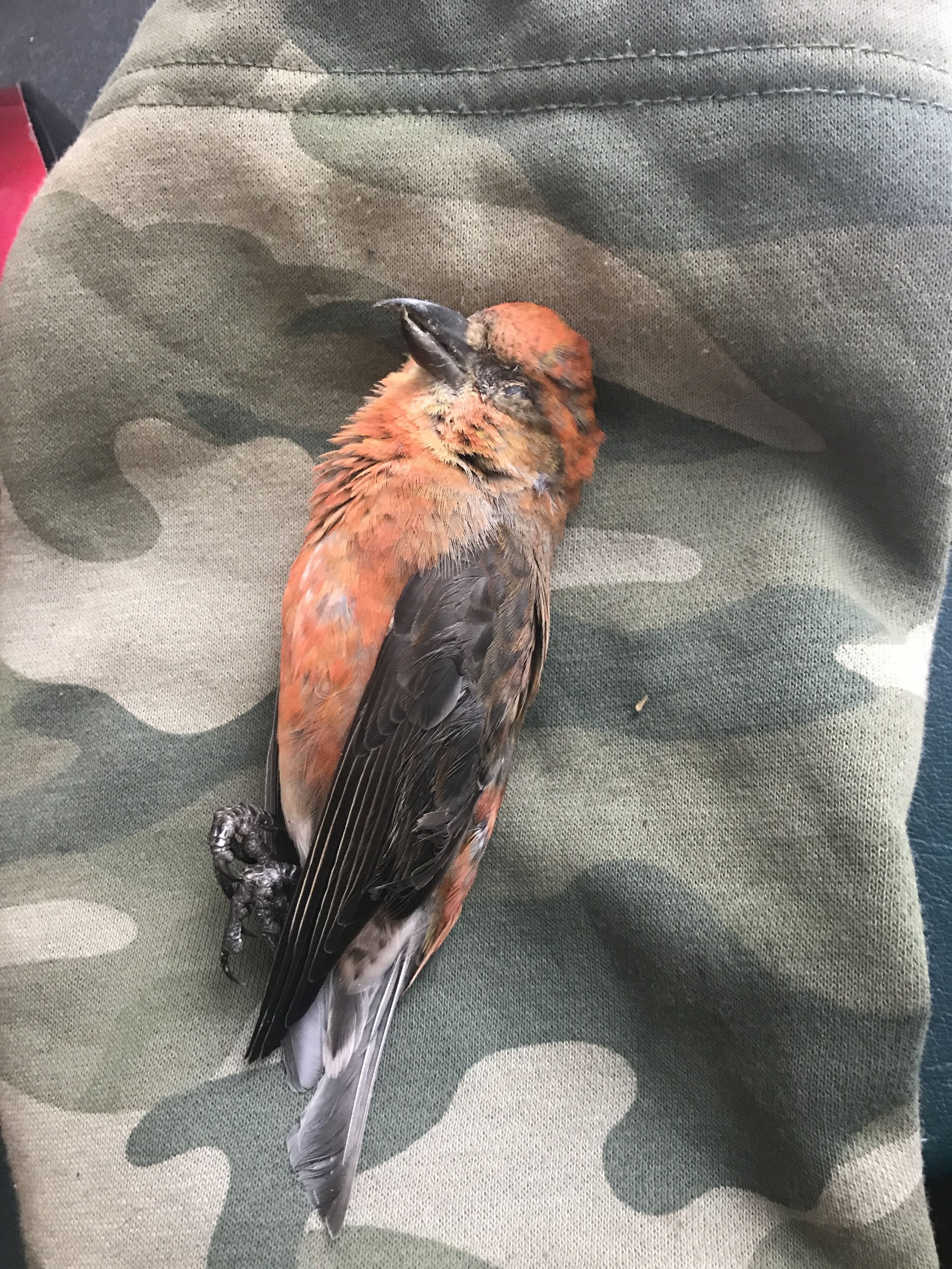

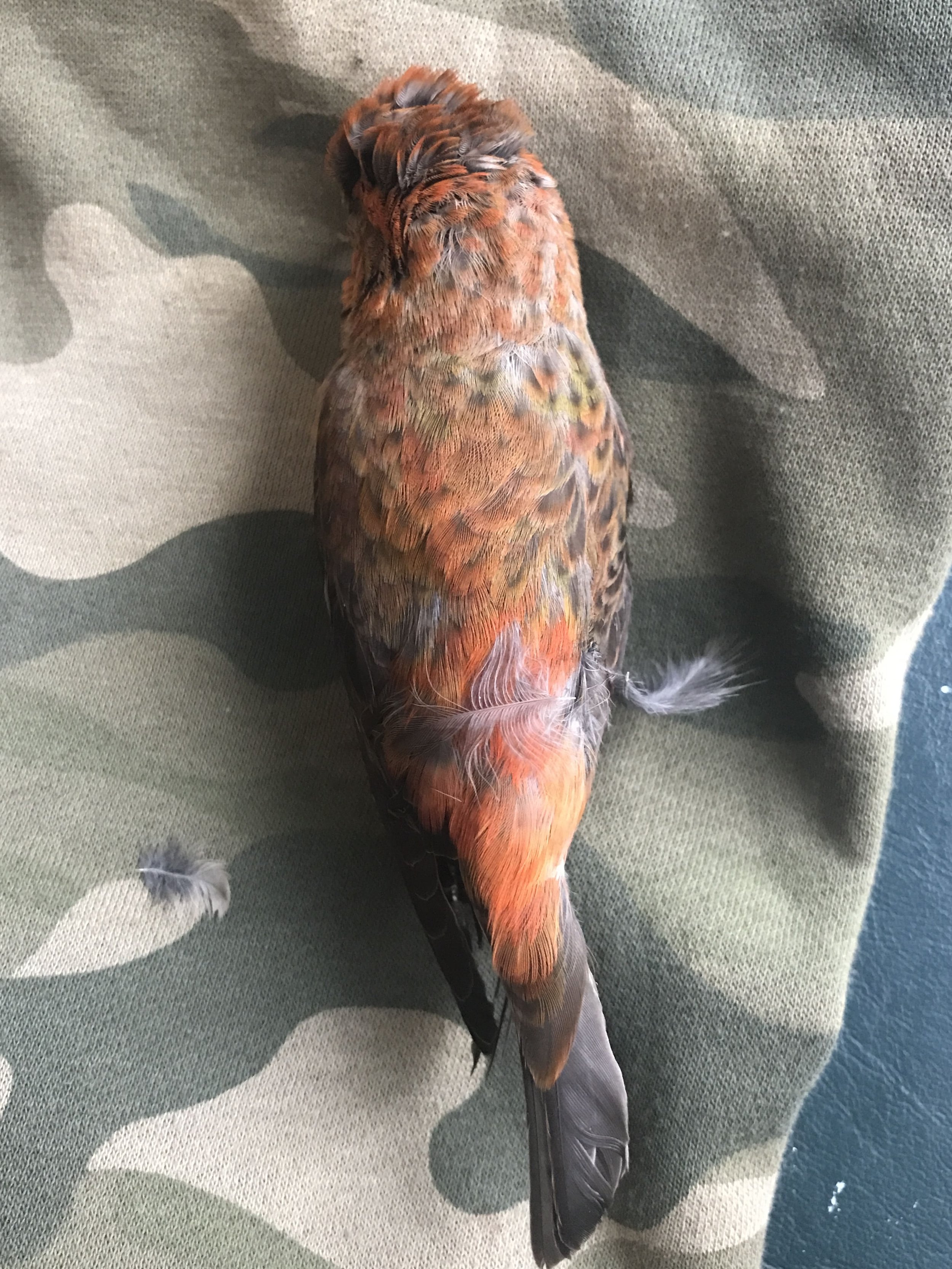
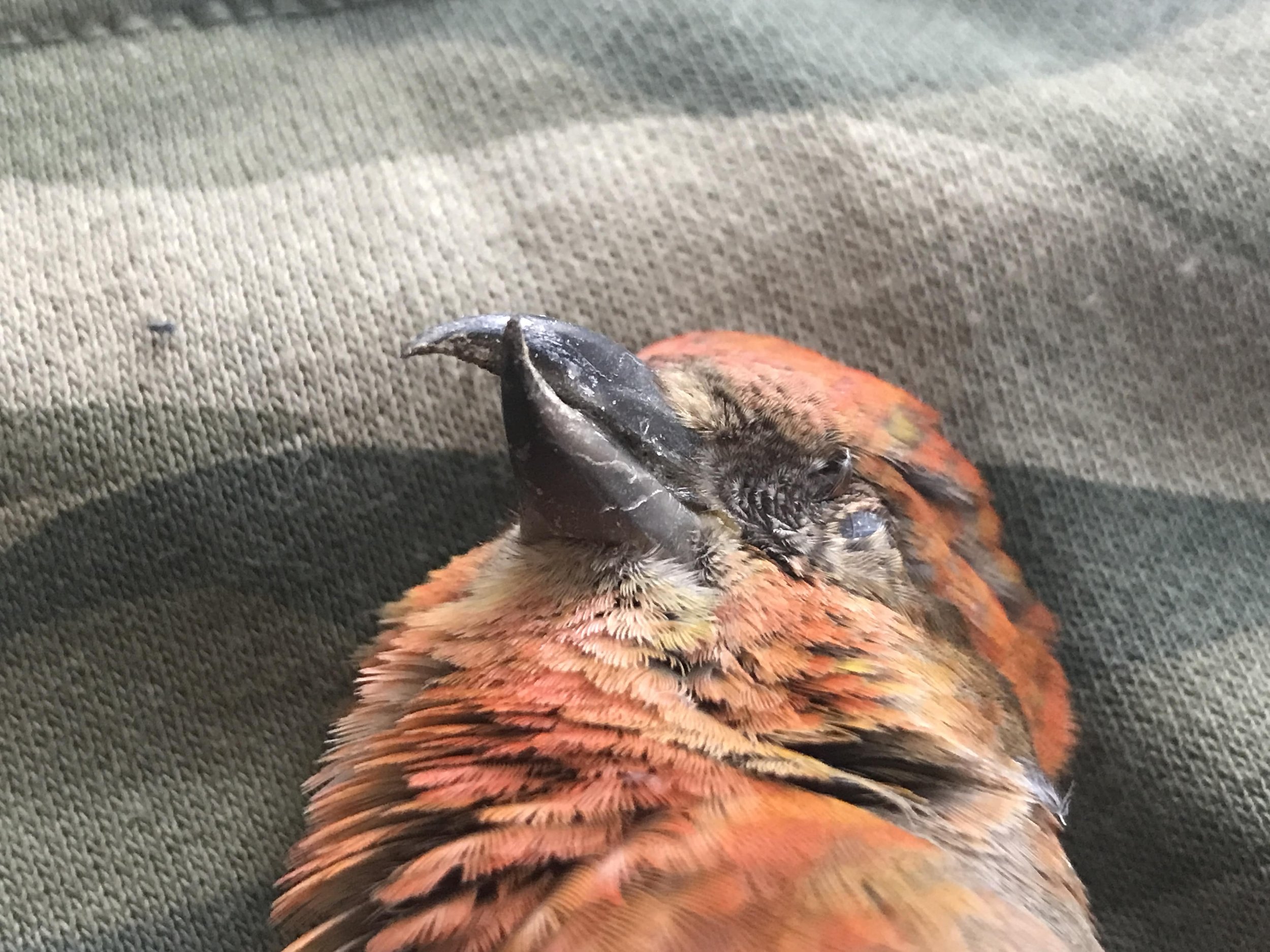
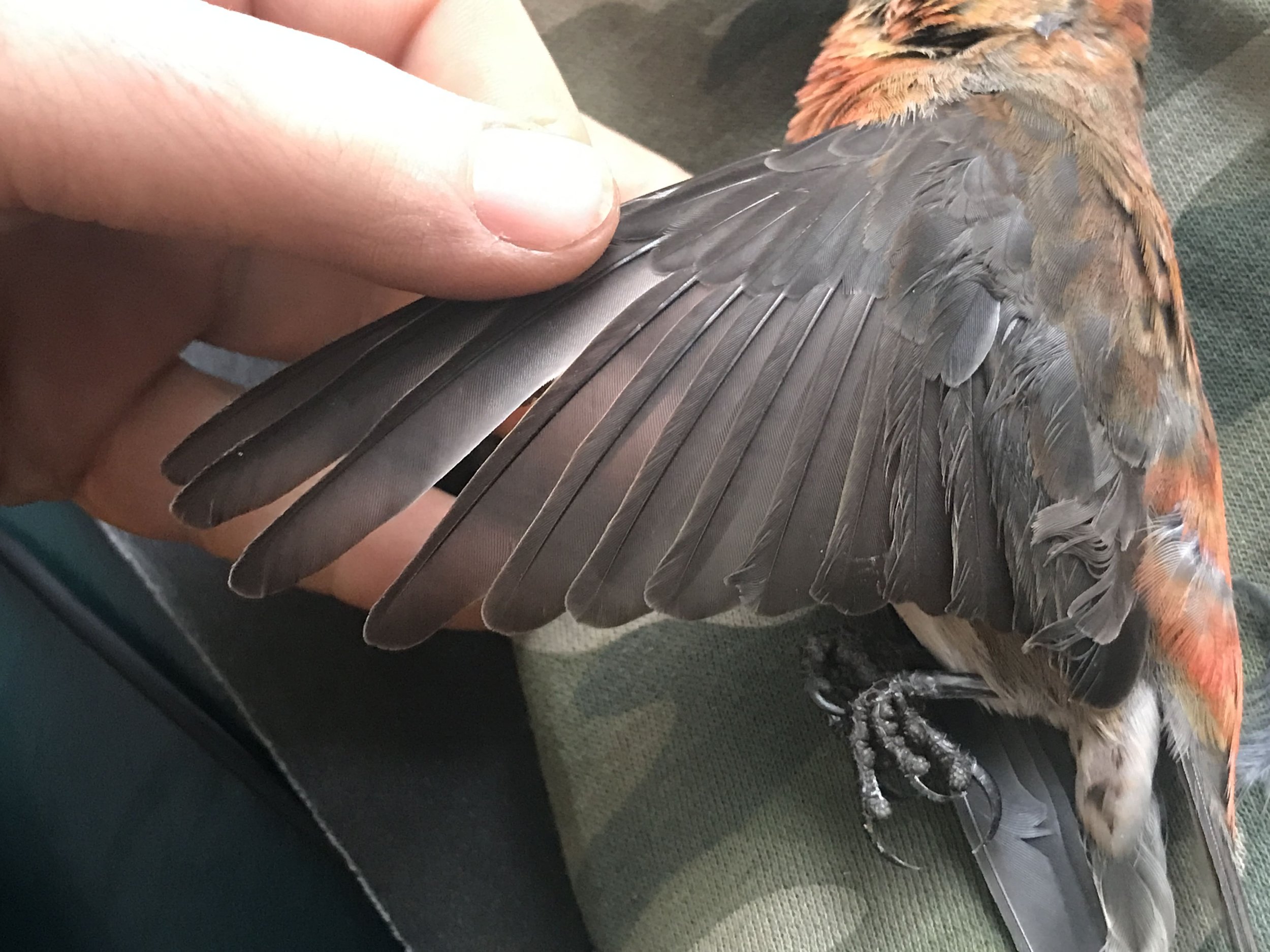
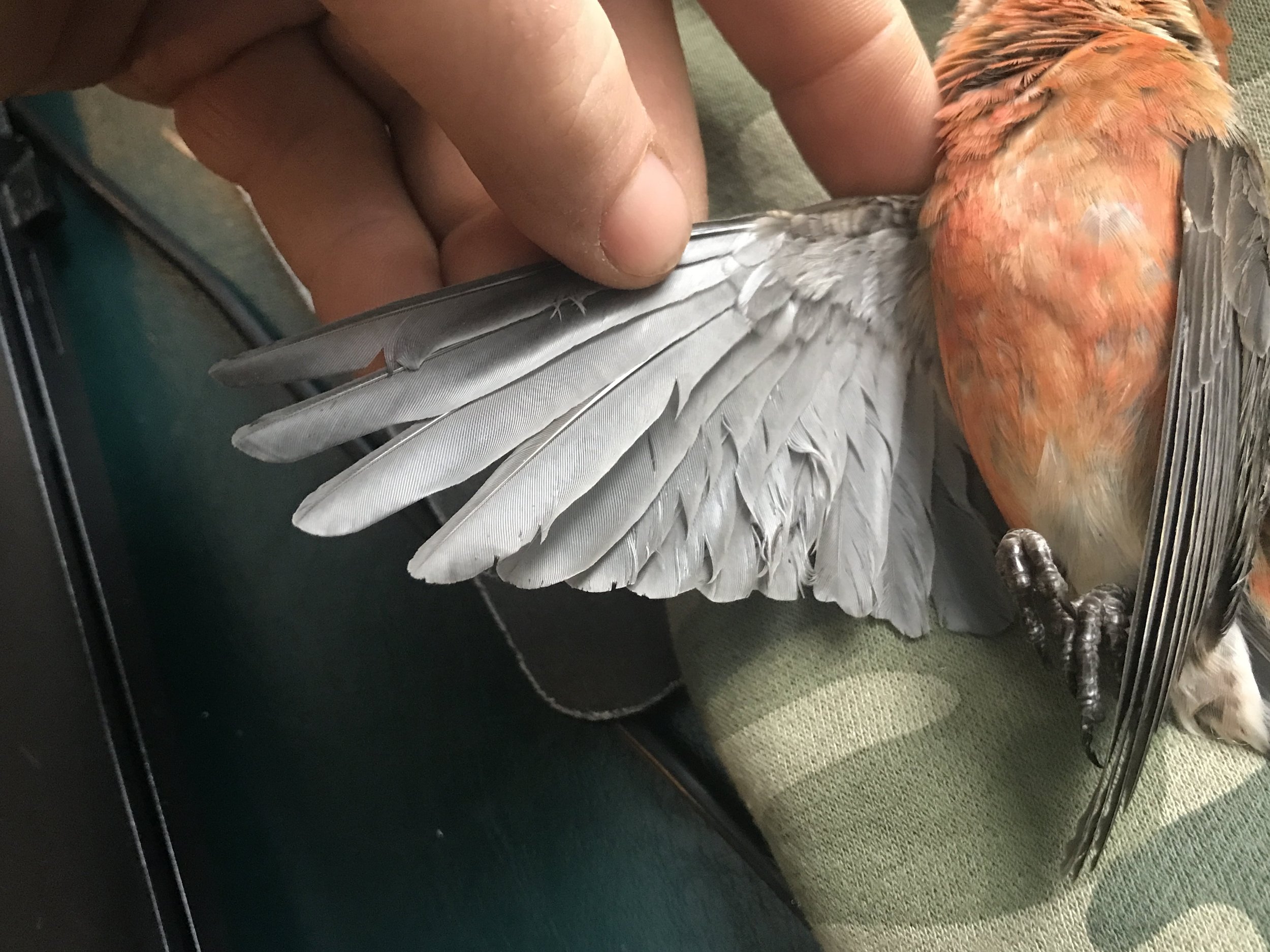
Despite getting the chance to hold and really look close at the Crossbill I did not think to measure the foot length.
Tyler Hoar of the Finch Research Network writes that the Winter of 2023-2024 is a big year for Red Crossbills throughout Southern Ontario due to a sparse year of Spruce cones in the Northern boreal forests where a lot of Crossbill visitors are coming from. They have come South in search of a large crop of White Pine cones and seed. When birds come down looking for better food sources we call these irruptive years. This is true for the Pine Siskins as well, although they have a more generalist seed eating diet than the more specific Crossbills.
The Red Crossbill’s diet can be pretty damned specific. There are different populations of Crossbill whose bills have evolved to specialize in opening cones and retrieving seeds from specific conifer species. Some may be better able to wedge their bills into a White Pine, while others may be better suited to extract and husk Eastern Hemlock (Tsuga canadensis) seeds. In Cornell’s Handbook of Bird Biology (3rd ed., 2016) I read about a study where they had two populations of Red Crossbills from different geographic regions (Rocky Mountain (RM) and South Hills (SH) regions) try and open the cones of Lodgepole Pines (Pinus contorta) originating from the two distinct areas where the two populations of Red Crossbills were from. RM Crossbills could open the cones from their own region in 5 seconds, and the cones from SH in about 7 seconds. The SH Crossbills could open RM cones 13 seconds, but cones from their own SH region in 6 seconds! This is theorized to be due to coevolution in with the Lodgepole Pines in their own territories which helped shape and specify their bills to match their local Lodgepole, a coevolution which is also influenced by the presence of Red Squirrels (Tamiasciurus hudsonicus) who feed on the seeds from the Lodgepole Pine cones. I am curious to know if the Red Crossbill we found, and those we heard throughout the week, have specific relationships with specific species in the park, or whatever home region they are from up in the boreal forest?
Red Crossbills aren’t just reliant on a the conifers for a good food source. While other birds, who mostly mate in the Spring when their mating hormones are triggered by a longer photoperiod, Crossbills tend to breed opportunistically, like when they find an abundant seed crop. This makes sense on a lot of levels as a Human (Homo sapiens). I feel that coming across the abundance needed for producing a clutch would be the most appropriate time to mate and begin nesting. The lengthening photoperiod (the period of light in a day) and promise of Spring are general securities for raising young, but the immediate abundance seems like a good motivator. I wonder what other factors there are that influence the mating period that Humans just don’t know about?
Black-backed Woodpecker (Picoides arcticus)
White Pine (Pinus strobus) trunk with the bark scaled off. Rock Lake, Algonquin Park, 2024.02.14.
This is the first year of the Winter Wildlife Tracking Weeklong that I have managed to remember to get a photo of this incredible and extensive behaviour likely done by Black-backed Woodpeckers. What’s going on in the photo? This is a large White Pine tree which has had a ton of the outer bark chipped off. I think in the field we may have called this behaviour bark sloughing, which is when a bird removes the entirety of outer bark of a tree. Rather than sloughing, this tree looks like it has had the outer scales of bark removed, which is called bark scaling. I have read both terms used interchangeably or to describe the opposite of what I have described above; scaling for when the entirety of the bark is removed and sloughing for when only chips of outer bark has been removed. Despite this confusion, I am going to stick with these definitions previously mentioned: here, bark scaling means chipping at outer bark only, while sloughing implies removing larger pieces the bark down to the wood.
The bark scaling behaviour in the photo above is a common enough sight in Algonquin and I feel I have seen it before on other Pines, Hemlocks, and maybe even other trees such as some of the Firs (Abies spp.) or Spruces (Picea spp.). Why are they sloughing the bark? To get at small bark boring beetles which live and feed below the outer bark. Who is the insect which the Black-backed Woodpecker was feeding on? Likely the Hemlock Borer (Phaenops fulvoguttata) which is a common small (8-11 mm L) bark borer in found throughout Southern Ontario. The Hemlock Borer is black with three yellowish spots on each elytron (wing covers) in a crescent pattern. They have been recorded on different species such as the Balsam Fir (Abies balsamea), Tamarack (Larix laricina), White (Picea glauca), Red (P. rubens), and Black Spruce (P. mariana), and again, the White Pine and Eastern Hemlock. The Hemlock Borer and other bark boring beetles (Buprestidae) show up more readily on trees which are already dealing with heavy environmental stressors such as low water availability, high tree density, or recent fires. And, in another instance of a bird co-evolving with other species in their environment, researchers believe that the Black-backed Woodpecker has black plumage all down their back because of this diet of bark boring beetles. Black-backs have evolved to be camouflaged against the blackened barks of fire scorched conifers where, again, their bark boring beetle prey deposit their young and where the larvae grow. What a cool adaptation! While burned areas are preferential for P. arcticus, they may also be found frequenting boreal forests with conifers and aspens.
Likely galleries of the Hemlock Borer (Phaenops fulvoguttata) exposed by Black-back Woodpecker (Picoides arcticus) bark scaling.
Pileated Woodpecker (Dryocopus pileatus)
While out with a small group on the Thursday of our weeklong adventure in Algonquin we came across a beautiful dead trunk, likely of a Big-toothed Aspen (Populus grandidentata) full of diverse animal sign. We found Beaver (Castor canadensis) chews at the bottom which girdled the tree and likely initially wrought the tree’s doom, along with a number of large Pileated Woodpecker holes with Carpenter Ant (Camponotus spp.) galleries within. The larger Pileated holes can be pretty wide and fairly long (I have measured one at 75 cm, or 29½” long, and I have seen larger) and deep enough to peer into the dark hollowed heart of the tree where the Carpenter Ants have set up their colonial homes.
If you look carefully along the side walls of the Pileated holes, you can often find the marks of the stout bill of the woodpecker from when they were repeatedly smashing their heads against the tree. It seems that for a long time researchers have wondered how all of the woodpeckers who smash their bills against the trees can do this without suffering from any sort of brain damage. Some folks talk about the tongue of many woodpecker species being so long that it wraps around the braincase acting as a cushion for the brain, similar to an air bag in a vehicle helps reduce injury in the case of an accident. Another paper I found was all about how woodpeckers can’t get concussions when using the amount of force that they do. They write that despite smashing their heads with accelerations up to three times that of the human concussion threshold that “these [woodpecker] species would need to hit their selected spots twice as fast as observed or strike at its top speed on wood that is four times as stiff to suffer a concussion.” The video abstract from their paper is embedded below.
Back to Algonquin, this tree we were examining was a special tree, not only for us but also for all the species which had interacted with the tree since they had died or been in decline.
While we were attending to the varied sign on the tree, a Pileated Woodpecker flew in and began hammering away at the wood in another Populus tree just off to the side of where we were standing. We watched silent and still for quite a while, and then began to move a little bit hastier and noisier once we realized our movements weren’t likely to push off the Pileated. We made our way up a small hill back to the trail and realized we were on the same level as the great bird. We stayed with the bird, watching how they titled their head this way and that to gain better leverage to chisel away at the rotten trunk. When we heard a snowmobile coming we stepped off the trail once more. The Pileated took off and alighted on a another nearby tree but this time further into the brush of the forest. Once the roar of the engine had passed, the woodpecker returned and got back to enlarging their new cavity. We noticed some hesitation now and then in the head movements of the bird and realized thought that this was when they were actively feeding on the insect prey inside.
A question I have, which I was actively looking out for in Algonquin, was if Pileated Woodpeckers tend to create their feeding holes on the South side of the trees more often than other directions? By the end of the week, it seemed the total number of holes facing South seemed higher than holes facing any other direction, when counted individually, but the South facing holes were not what I saw the majority of the time. In my follow up research I read the Pileated Woodpecker chapter from Life Histories of North American Woodpeckers by Arthur Cleveland Bent (who used the scientific name of Ceoploeus pileatus abieticola Bangs for the bird) and there he notes that his correspondence all seem to agree that most of these holes are done in the Winter. I find this intriguing because this is what I have seen as well when it comes to the excavations made closer to the ground. Why closer to the ground? As the months grow colder, Carpenter Ants tend to congregate in the warmer parts of the trees, and in Southern Ontario that means down near the bottom of the trunk, or the bole as it is sometimes called. The ants gather closer to the ground as the ground temperature is warmer than the Winter ambient air temperature. The ants then enter a state of diapause where development and growth is stilled until warmer temperatures return, usually lasting between 3 - 4 months, though I wonder if the ants become active during the warmer breaks in Winters like this year?
From Bent’s chapter on Pileated Woodpeckers, also known as Log-cocks:
Of the major wintertime operations Vickers (1910) has written:
Like the flicker, the [pileated woodpecker] is a great lover of ants, which accordingly occupy a large place in his bill-of-fare. So, to dine on the big black timber ants, which are his special delight, he drives holes to the very heart of growing forest trees, tapping the central chamber of the colony, where, in winter, he finds the dormant swarm unable to move and feasts upon them at leisure. . .And the Log-cock makes no mistakes, though man might find no outward sign of an ant-tree. Doubtless that strong formic smell, coupled with his experience in sounding tree trunks--as a man tells a ripe watermelon by the 'plunk' of it--enables him not only to find the tree, but, what is more remarkable, to drive his hole with such precision that he taps the heart of the community.
The Pileated holes often become homes for other animals as well, such as Flying Squirrels (Glaucomys sabrinus and G. volans), owls, Peromyscus mice, and likely more. I wonder if these animals may feed on the ants within as well? Also, how much bark scaling or sloughing would a Pileated get up to? So many questions.
Ruffed Grouse (Bonasa umbellus)
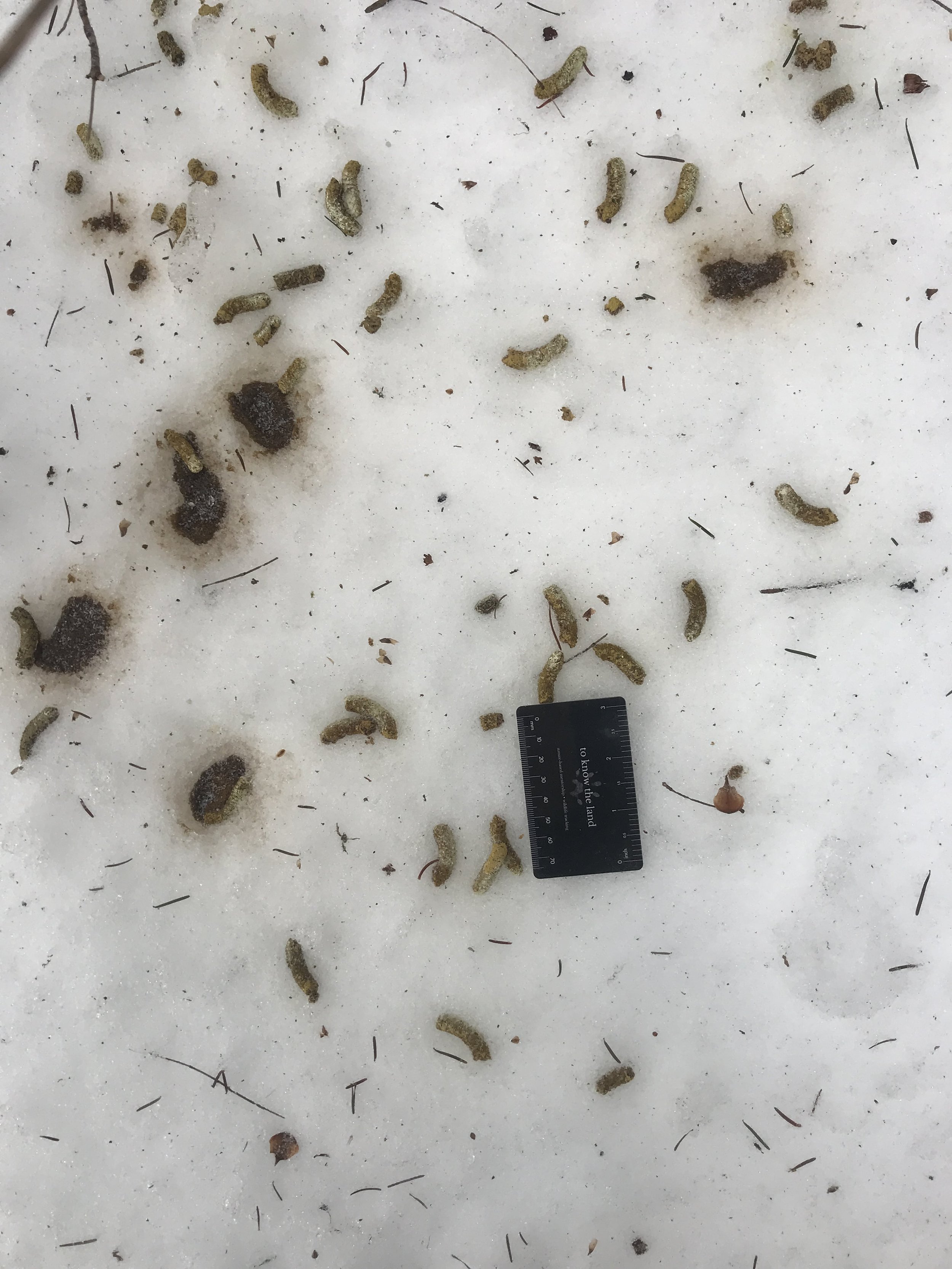
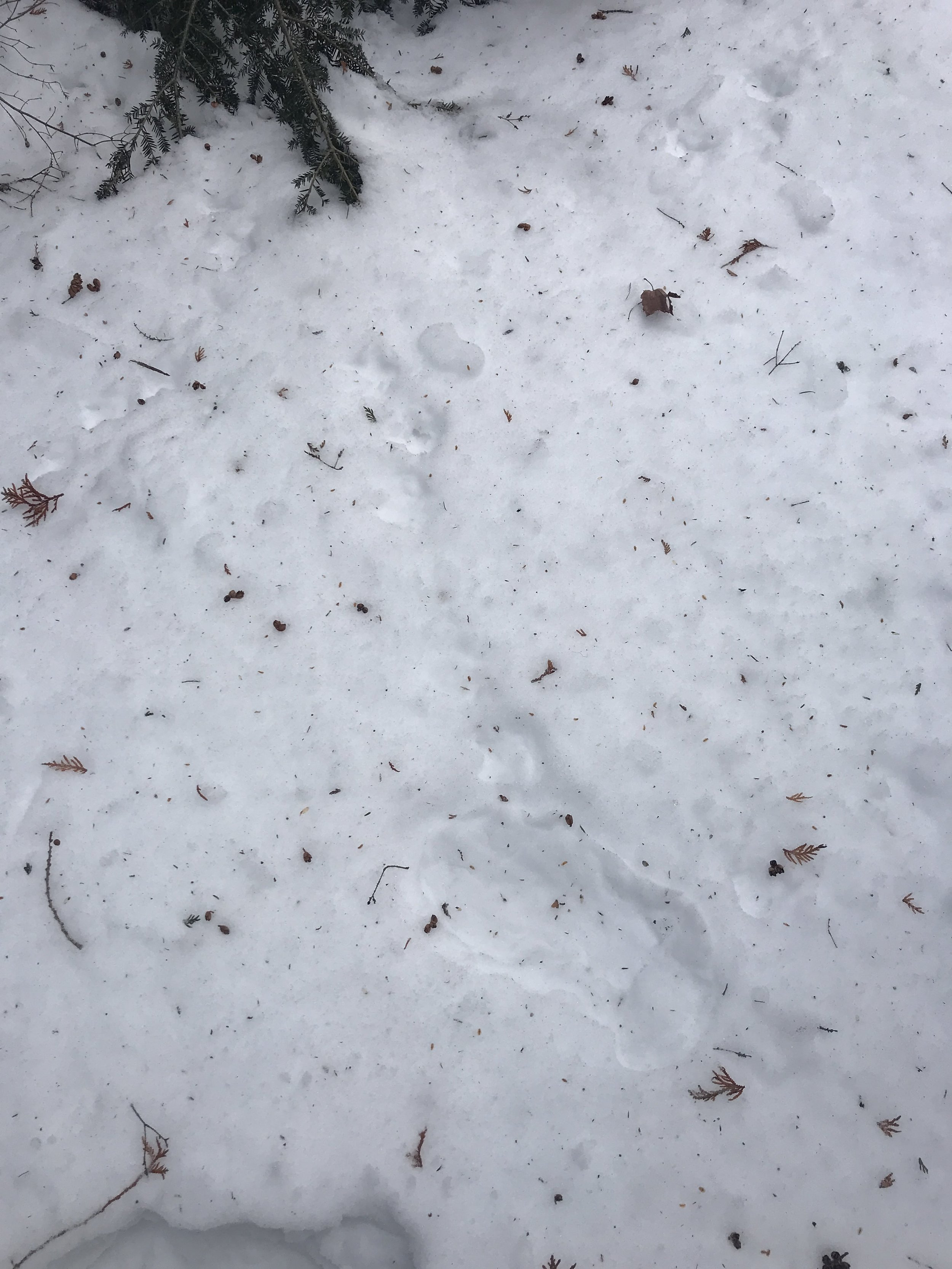
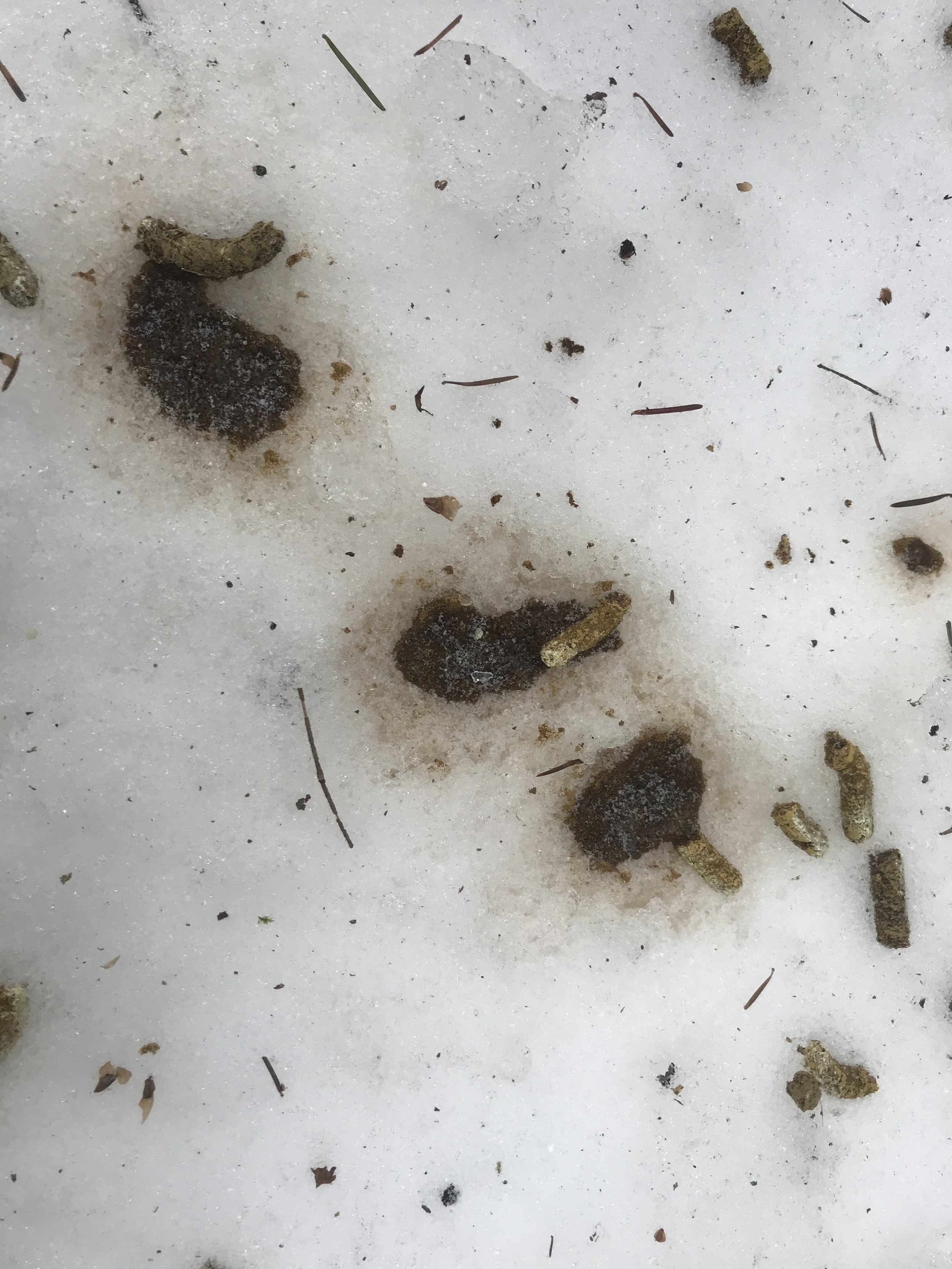
Throughout the week there were quite a few trails made by the Ruffed Grouse. Often an indistinct trail in the melted and blown over snow, the trail could be sorted by looking at the width and seeing where it appeared to suddenly begin or surprisingly stop.
The Ruffed Grouse isn’t the only grouse in the park, as the Spruce Grouse (Falcipennis canadensis) are also present, though I have heard more commonly found on the Eastern side of the park. Their tracks are very similar according to Elbroch (2001) with the Spruce Grouse tracks measuring 3.8 - 5.7 cm (1½ - 2¼ in) L x 5.1 - 6 cm (2 - 2⅜ in) W and the Ruffed Grouse coming in at 4.1 - 5.7 cm (1⅝ - 2¼ in) L x 4.4 - 6 cm (1¾ - 2 ⅜ in) W. While the trails of the Ruffed Grouse can be confused with some other species it is good to look for the game bird tracks, similar to Wild Turkey (Meleagris galopavo) though smaller.
Another sign of Ruffed Grouse are their two types of scat we found. First type of scat was their liquidy, or frozen, cecal scat which is often pale brown and often sunken somewhat into the snow, when there is any. This scat doesn’t last for a long time and will soon wash away as the snow melts. The second type of Grouse scat seems to persist quite a bit longer. It appears as a dry, compressed tubular pellet with a slight crescent-like curve to them, often with a bit of white uric acid on one end. These scats are made up of tiny pieces of plant material which did not breakdown throughout the digestive journey.
When monitoring Ruffed Grouse snow roosts (learn more about Ruffed Grouse snow roosts here), biologist, author, and writer Bernd Heinrich noticed that the Ruffed Grouse were depositing roughly 3.7 fecal pellets per hour. This has become a bit of scat math that I have come to practice whenever I come across Ruffed Grouse scat in the woods (thanks for the hot tip, Tamara!). By looking at the images you can get an idea that the Grouse who expelled these pellets was likely there for over 8 hours. When it comes to food, Bernd also noticed that in only 15 minutes the Grouse can fill their crops with enough tree buds to last them through the night. I imagine then that a Ruffed Grouse only needs to be up and bopping around for such a short period of time. This is a great strategy to minimize energy waste throughout the colder times of year.
Now there is so much more I need to learn about when it comes to bird sign, and it is going to take more years of observing and researching, and likely stepping up how I observe, record and even setting up some more experiments to get at the answers I am after. For now, I am grateful for the birds and the lands they inhabit and shape, for Alexis and the apprenticeship, and for everyone who came out for the Winter Wildlife Tracking weeklong in Algonquin Park. And just so you know, next year’s dates are Feb 9th - 14th, 2025, so save the dates!
To learn more :
McGill Bird Observatory’s Migration Research Lab
Winter Finch Forcast 2023-2024 by the Finch Research Network
Cornell’s Handbook of Bird Biology edited by Irby J. Lovette and John W. Fitzpatrick. Wiley-Blackwell, 3rd ed. 2016.
10 Types of Woodpecker Holes and Other Woodpecker Sign on Trees
Peterson Reference Guide to Woodpeckers of North America by Stephen A. Shunk. Houghton Mifflin Harcourt, 2016.
Woodpeckers minimize cranial absorption of shocks paper by Sam Van Wassenbergh, Erica J. Ortlieb, Maja Mielke, Christine Böhmer, Robert E. Shadwick, Anick Abourachid
Life Histories of North American Woodpeckers by Arthur Cleveland Bent. Smithsonian Institution United States National Museum Bulletin, 1939.
Bird Tracks and Sign by Mark Elbroch. Stackpole Books, 2001.
How Do Birds Survive The Winter? by Bernd Heinrich



